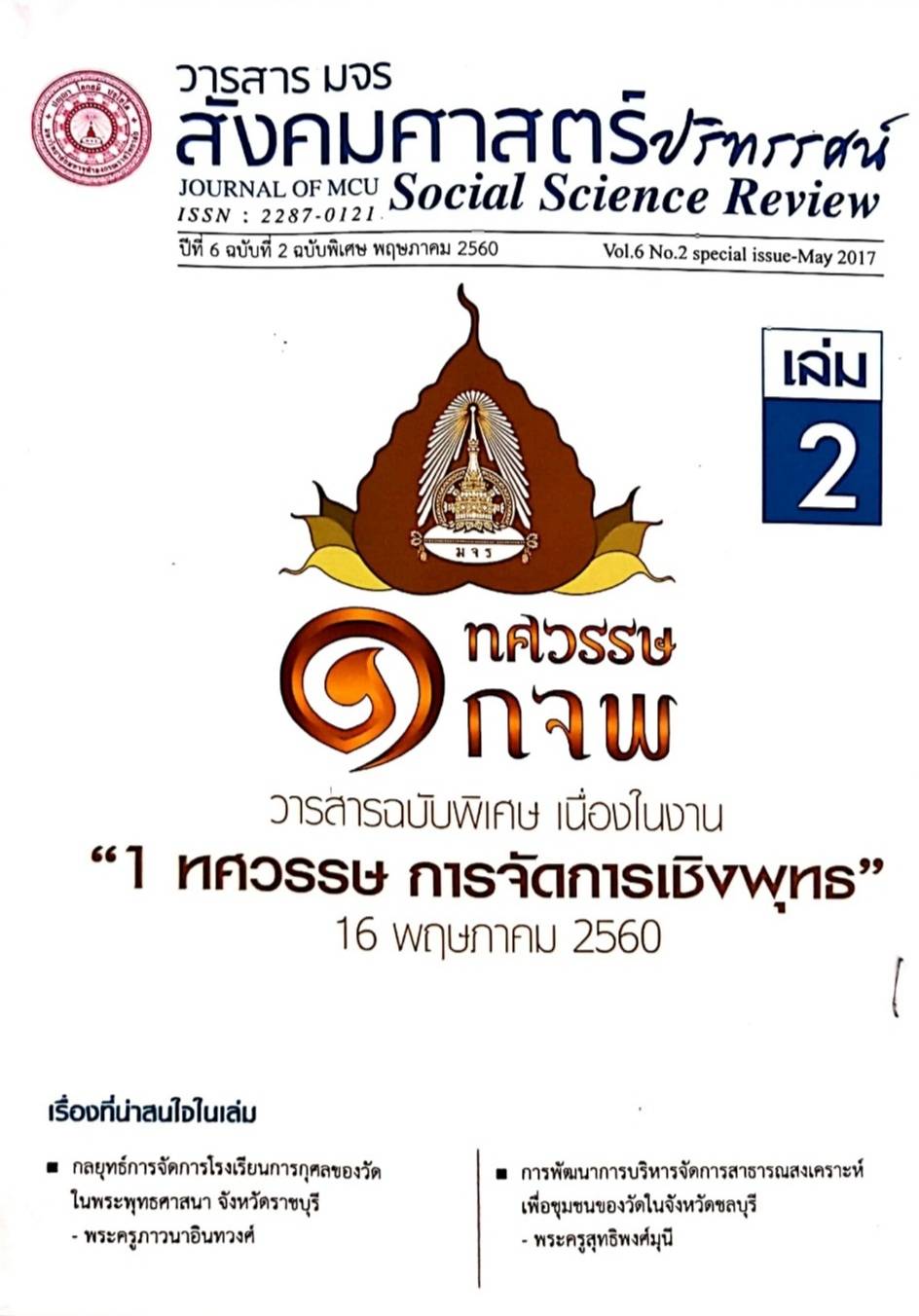การอนุรักษ์ และพัฒนารูปแบบการจัดการระบบนิเวศทางวัฒนธรรม พุทธสถานภาคอีสานตอนล่าง
คำสำคัญ:
การจัดการระบบนิเวศทางวัฒนธรรม, พุทธสถานบทคัดย่อ
การวิจัยนี้มีความมุงหมาย เพื่อศึกษาประวัติ ความเป็นมา สภาพปัจจุบัน ปัญหาการอนุรักษ์ และการพัฒนารูปแบบการจัดการระบบนิเวศทางวัฒนธรรมของพุทธสถานภาคอีสานตอนล่าง ตั้งแต่เดือนมีนาคม พ.ศ. 2557 ถึง เดือนมิถุนายน พ.ศ. 2558 ทำการศึกษาจากพุทธสถาน8 แห่ง ในพื้นที่ 4 จังหวัด จังหวัดละ 2 พื้นที่ มี วัดมกุฏคีรีวัน วัดเลิศสวัสดิ์ วัดเขาพระอังคาร วัดป่าโคกกระชาย พุทธอุทยานวัดเขาศาลาอตุลฐานะจาโร วัดป่าเขาโต๊ะ สำนักสงฆ์ป่าหนองม่วง และสานักสงฆ์พุทธอุทยานดอนแก้วห้วยวะ ใช้ระเบียบวิธีวิจัยเชิงคุณภาพ เก็บข้อมูลภาคสนามประกอบด้วยการสำรวจ สังเกต สัมภาษณ์ และสนทนากลุ่ม จัดกระทาการวิเคราะห์ข้อมูลและนำเสนอผลการวิเคราะห์ข้อมูล ด้วยวิธีพรรณนาวิเคราะห์ ผลการวิจัยพบว่า การอนุรักษ์และพัฒนารูปแบบการจัดการะบบนิเวศทางวัฒนธรรมของพุทธสถานภาคอีสานตอนล่าง มี 7 รูปแบบ คือ 1)สวนป่าเป็นแหล่งต้นน้ำลำธาร 2) ป่าชุมชนพัฒนาเป็นป่าไม้ถาวร 3) องค์กรป่าชุมชนและเครือข่าย4) ป่าชุมชนอนุรักษ์พัฒนาเป็นป่าเบญจพรรณ 5) พุทธอุทยานระบบนิเวศดั้งเดิม 6) ป่าชุมชนแบบระบบนิเวศดั้งเดิม และ 7) พุทธอุทยานระบบนิเวศป่าบุ่งป่าทามสรุปได้ว่า การอนุรักษ์ และพัฒนารูปแบบการจัดการระบบนิเวศทางวัฒนธรรมภาคอีสานตอนล่าง เป็นแหล่งป่าต้นน้า อาหาร สมุนไพร โบราณคดี สถานที่พักผ่อนหย่อนใจ เป็นศูนย์อบรมศีลธรรม คุณธรรม และจริยธรรม เป็นแหล่งค้นคว้าวิจัยข้อมูลพื้นฐานทางระบบนิเวศทางวัฒนธรรมในการรักษาความหลากหลายทางพันธุกรรมของพืชและสัตว์ สร้างความสมดุลแก่ระบบนิเวศพุทธสถาน ส่งเสริมกระบวนการเรียนรู้เพื่อจัดทาแผนพัฒนาพุทธสถานให้ทันกระแสแห่งโลกที่ทันสมัย เตรียมความพร้อมต่อการพัฒนาระบบนิเวศทางวัฒนธรรมเพื่อรองรับการเปลี่ยนแปลงทางเศรษฐกิจและสังคม ของประชาคมอาเซียน สามารถนามาประยุกต์ใช้ในชุมชนและสังคมอย่างยั่งยืน
เอกสารอ้างอิง
Ecological Landscape Restoration Guidelines for Boundary Forests: A case study of buffer zone areas. Phu Khieo Wildlife Sanctuary Chaiyaphum Province Master of Landscape Architecture, Graduate School: Silpakorn University, 2011.
Pong Nakorn Yang Ngam and Peter Pan persistently promote the process of creating public participation. <Http://www2.diw.go.th/ppp/data/pdf/journal1.pdf>. April 27, 2557.
A study of the role of monks and the conservation of forest resources: a case study of Phra Nirasakorn Sopon (Kraianthis Saro), Nong Bua Temple, Nong BuaDistrict, Nakhon Sawan Province. Master of Buddhist Thesis The branch of Buddhism Graduate School: Mahachulalongkornrajavidyalaya University,2011.
Buddhist monks (Buddhist monks) Buddhist monks and forest conservation. "Sikhism" magazine. Year 2 No. 9 January - February, 1992.
Brother Prasan Panya and the castles of Great Wall, Sisaket Province. The Millionaire for Education Fund: Sisaket, 2555: 26 An appropriate form of conservation, rehabilitation and development of cultural forests in the Isan Forest Temple, where the community ]participates. Doctor of Philosophy Doctorate Faculty of Culture Science. GraduateSchool: Mahasarakham University, 2008.
ดาวน์โหลด
เผยแพร่แล้ว
รูปแบบการอ้างอิง
ฉบับ
ประเภทบทความ
สัญญาอนุญาต
ลิขสิทธิ์ (c) 2020 วารสาร มจร สังคมศาสตร์ปริทรรศน์

อนุญาตภายใต้เงื่อนไข Creative Commons Attribution-NonCommercial-NoDerivatives 4.0 International License.
เพื่อให้เป็นไปตามกฎหมายลิขสิทธิ์ ผู้นิพนธ์ทุกท่านต้องลงลายมือชื่อในแบบฟอร์มใบมอบลิขสิทธิ์บทความให้แก่วารสารฯ พร้อมกับบทความต้นฉบับที่ได้แก้ไขครั้งสุดท้าย นอกจากนี้ ผู้นิพนธ์ทุกท่านต้องยืนยันว่าบทความต้นฉบับที่ส่งมาตีพิมพ์นั้น ได้ส่งมาตีพิมพ์เฉพาะในวารสาร มจร สังคมศาสตร์ปริทรรศน์ เพียงแห่งเดียวเท่านั้น หากมีการใช้ภาพหรือตารางหรือเนื้อหาอื่นๆ ของผู้นิพนธ์อื่นที่ปรากฏในสิ่งตีพิมพ์อื่นมาแล้ว ผู้นิพนธ์ต้องขออนุญาตเจ้าของลิขสิทธิ์ก่อน พร้อมทั้งแสดงหนังสือที่ได้รับการยินยอมต่อบรรณาธิการ ก่อนที่บทความจะได้รับการตีพิมพ์ หากไม่เป็นไปตามข้อกำหนดเบื้องต้น ทางวารสารจะถอดบทความของท่านออกโดยไม่มีข้อยกเว้นใดๆ ทั้งสิ้น





